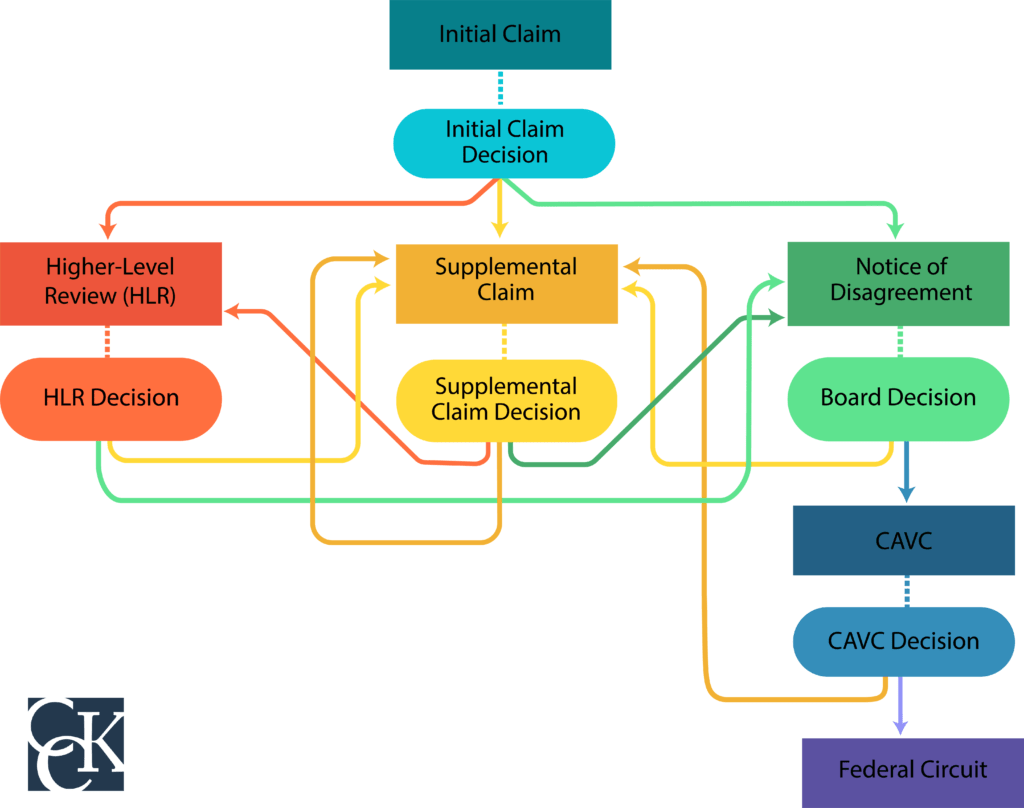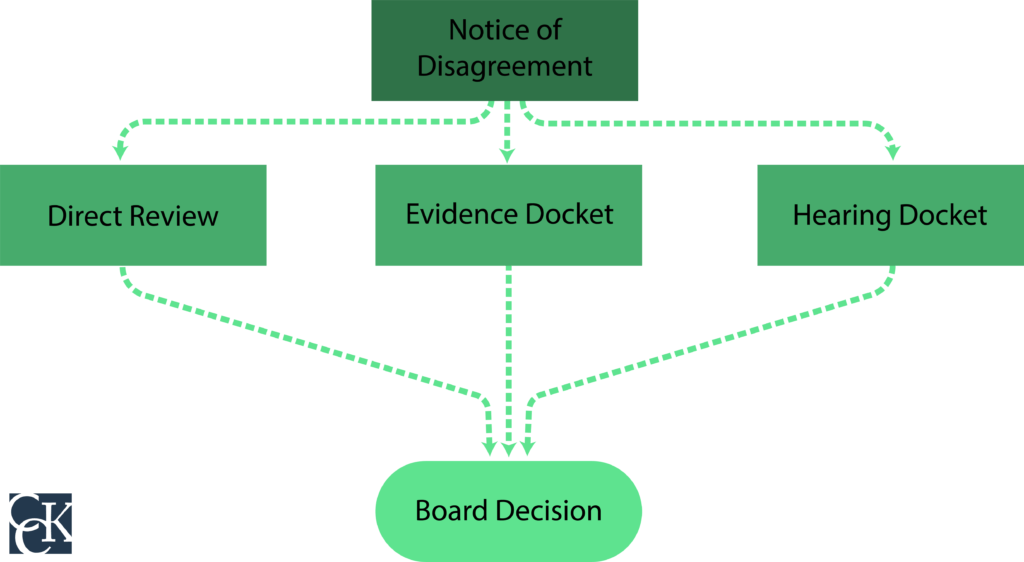The Rapid Appeals Modernization Program (RAMP): In Review

CCK Law: Our Vital Role in Veterans Law
In November of 2017, the Department of Veterans Affairs introduced the Rapid Appeals Modernization Program (RAMP), which served as a pilot program to test the new appeals system enacted into law by the Veterans Appeals Improvement and Modernization Act of 2017 (Appeals Reform). The procedural process for claims and appeals pending within the VA benefits system will completely change upon full implementation of Appeals Reform on February 19, 2019.
Established by an act of Congress, this legislation seeks to reduce the current backlog of claims within the VA system, thereby reducing the time veterans must wait for a decision on their disability claims. Additionally, the new VA appeals process provides veterans with various review options, or lanes, upon receiving a decision with which they disagree.
Our team took a look at the results of the Rapid Appeals Modernization Program (RAMP) to assess how the program operated and veterans’ experiences with it—some concerns remain.

Rapid Appeals Modernization Program (RAMP) at the Agency of Original Jurisdiction Level
As of November 2018, approximately 75,000 appeals were transferred from the Legacy system (VA’s current appeals process) to the Rapid Appeals Modernization Program. On average, veterans are waiting about 119 days to receive a decision in RAMP, which is significantly faster than those appealing under the Legacy system. Since VA invited veterans to join the Rapid Appeals Modernization program, the appeals inventory has been reduced by 14%. This is likely due to the fact that claims are being moved from one system to the other.
Currently, veterans appealing decisions at the Agency of Original Jurisdiction (AOJ) level (e.g. Regional Office) only have the option of filing a Notice of Disagreement, followed by a linear claim stream. Unlike Appeals Reform, the Legacy system does not provide veterans with multiple appellate choices. Instead, there is only one review option at each stage. Under RAMP and the reformed VA appeals system, veterans have three lanes to choose from upon receiving an unfavorable decision from the Regional Office:

- Higher-Level Review. Veterans cannot submit additional evidence into the record when selecting this appeal option. More experienced VA employees at the Regional Office level adjudicate appeals in this lane using the evidence that was already of record at the time of the initial decision.
- Supplemental Claim. Veterans can submit new and relevant evidence to support their claim. VA has a duty to assist veterans in gathering this evidence. Effective dates are preserved as long as veterans submit a supplemental claim within one year of the Regional Office’s initial decision.
- Notice of Disagreement. Veterans can file a Notice of Disagreement to appeal an unfavorable decision directly to the Board of Veterans’ Appeals. Here, veterans are able to skip the second level of review at the Regional Office.
It is important to note that veterans can appeal a decision from one lane to another lane. For example, veterans who receive an unfavorable decision in the Higher-Level Review lane can then choose to appeal it by submitting a supplemental claim with new and relevant evidence or filing a Notice of Disagreement to appeal directly to the Board of Veterans’ Appeals. Veterans who choose to appeal their claim to the Board, however, cannot then choose to appeal that decision to the Higher-Level Review option or again to the Board—these veterans would have to submit a supplemental claim with new and relevant evidence or appeal to the Court of Appeals for Veterans Claims (CAVC).
Rapid Appeals Modernization Program (RAMP) at the Board of Veterans’ Appeals Level
When the Rapid Appeals Modernization Program first started, the Notice of Disagreement lane (a direct appeal to the Board of Veterans’ Appeals) was not open to veterans. This lane was recently opened for veteran participation in October of 2018, so only a limited set of RAMP data at the Board is available.
To prepare for implementation of the new appeals process and to address its significant backlog, the Board of Veterans’ Appeals on-boarded over 240 additional employees in fiscal year 2018, bringing the total number of employees at the Board to over 1,000— double the number of individuals employed at the Board in 2013. Additionally, the Board issued decisions on a record-setting 85,288 appeals in FY 2018, a 62% increase from FY 2017. The Board has set a higher goal for FY 2019 of 90,000 appeals.
With all of these extra decisions, the Board has been issuing grants at a higher rate than in previous years. This has led to a new backlog for Board grant promulgations (i.e. Regional Office implementation of a grant of benefits), therefore, veterans are waiting longer to actually receive the benefits to which they are entitled.
How Does the New VA Appeals System Operate at the Board of Veterans’ Appeals?
Veterans who choose to appeal unfavorable decisions directly to the Board of Veterans’ Appeals must choose between three different docket options under the Notice of Disagreement lane:

- Direct Docket. The Board will only consider evidence that was in the veteran’s file upon initial adjudication of the decision being appealed. VA’s goal for issuing decisions in this docket is 365 days—predicted to be the fastest option. No hearings are held for appeals in the Direct Docket.
- Hearing Docket. Veterans may select to attend a hearing before a Veterans Law Judge either via videoconference or at the Board in Washington, D.C. New evidence may be submitted at the hearing or within 90 days following the hearing.
- Evidence Docket. Veterans are allowed to submit new evidence into the record with their Notice of Disagreement or within 90 days following its submission. No hearings are held for appeals in the Evidence Docket.
Which Docket are Veterans Choosing at the Board of Veterans’ Appeals?
As of January 1, 2019, the Board has received over 1,000 appeals of RAMP decisions. Of these 1,000 appeals, more than 50% have selected the Hearing Docket option:
- 310 veterans selected the Direct Review Docket
- 178 veterans selected the Evidence Docket
- 552 veterans selected the Hearing Docket
This trend could exacerbate the already tremendous backlog of claims currently awaiting a hearing in the Legacy system. Due to the current backlog, veterans who select to attend a hearing may wait for about five to seven years for their hearing date.
Concerns for Appeals Reform Implementation
Although VA has been preparing for this monumental change for over a year, some doubts linger among veterans, lawmakers, and veterans’ advocates about how smoothly the transition will go.
Information Technology Concerns
VA is creating a new IT system, Caseflow, aimed towards handling appeals in the new process. The concern here is that this software will not be operational by full implementation in February. Recently, IT failures surrounding the distribution of GI Bill funds caused student veterans to receive no payments or missed payments. These failures followed a legislative change that IT systems could not support, drawing concern from veterans’ advocates and lawmakers that Caseflow may experience similar problems.
Further, VA has indicated that none of the nine Caseflow products needed for implementation are fully finished as of January 2019, which has led VA to request additional contractor support.
Balancing the Legacy Appeals Backlog and New Appeals
Currently, there is a backlog of approximately 470,000 appeals at the Department of Veterans Affairs. Many are wondering how VA will balance the existing backlog along with the incoming appeals under Appeals Reform.
VA has set the goal of reducing the pending legacy inventory to a steady state by fiscal year 2020. Steady state indicates the elimination of all Legacy appeals in the Notice of Disagreement (NOD) and substantive appeal (VA Form 9) stages, with an inventory of remands that equals the number of appeals resolved per year. We estimate VA will complete all appeals in the Legacy system within five to seven years.
According to VA, Legacy appeals will be given priority upon implementation of Appeals Reform. This leads our team to believe that veterans who selected the Hearing or Evidence docket at the Board of Veterans’ Appeals under the new system will be given last priority.
Education, Training, and Awareness of the New System
The appeals process under this the reformed system is new to VA employees, Veterans Service Organizations, veterans, and veterans’ advocates alike. All involved expect to experience a learning curve in the beginning stages of this transition. We believe the lack of publicity around this change in law may cause insufficient awareness among the veteran community, further contributing to the learning curve.
In the decisions of some of our clients who have opted into the Rapid Appeals Modernization Program, we noticed similar adjudication errors that existed in the old system and average wait times of longer than VA’s goal of 125 days.
Conclusion
Full implementation of Appeals Reform is set for February 19, 2019. Veterans who receive decisions on or after this date will be required to participate in the new system in order to continue on with their appeals. As a firm, we feel confident in our knowledge of this legislative change. We recommend that veterans speak with a VA-accredited representative prior to selecting an appeal option.
If you are appealing an unfavorable VA decision, the experienced team of attorneys at Chisholm Chisholm & Kilpatrick LTD may be able to help you navigate this new system. We pride ourselves in fighting to get you the benefits you deserve. Contact us for a free consultation at 800-544-9144.
About the Author
Share this Post
